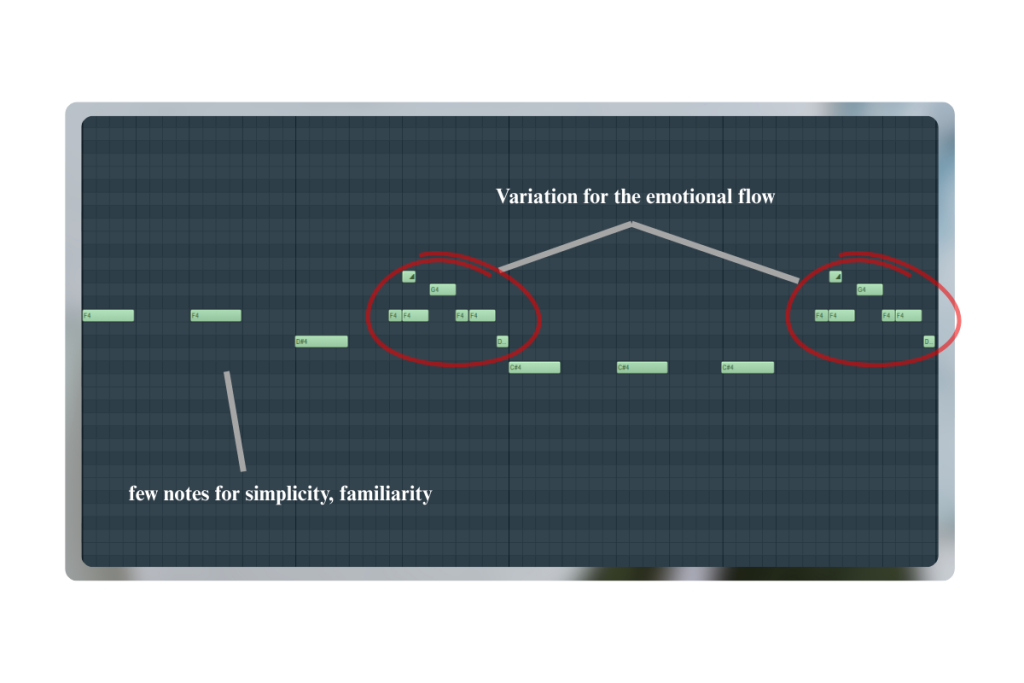Melodies are what hook listeners to a song. You’ve probably found yourself humming a melody more than once. That’s because of its catchiness and memorability. Look at some of the popular songs like “Happy” by Pharrell Williams, “Blinding Lights” by The Weeknd. What makes them stand out is their melodic simplicity. A song with a simpler rhythm and chord progression is more likely to be remembered by people.

In this blog, we will discuss essential tips on how to write a melody that is simple, yet memorable and unforgettable.
What is a Melody?
Melody refers to the sequences of notes that, when played collectively, form a musical tone. It includes two important elements: Rhythm and Pitch. Rhythm considers the pattern of notes played, while pitch involves how high or low a musical note is.
Melodies guide listeners to feel a certain way and experience the story that the musicians have to share. It helps evoke different emotions and a sense of character within the song. Without good melody writing and song arrangement, music fails to stand out in the vast pool of songs uploaded daily on streaming platforms.
Basic Components of a Melody
Here are some of the components that influence how the melody turns out.
Rhythm
Rhythm is how long or short your notes are spaced out. A catchy melody with good rhythm feels natural, like speech or breathing, and helps listeners follow along easily.
Pitch
Pitch tells you how high or low a note sounds. Writing melody becomes interesting when it moves between different pitches in a way that feels smooth or expressive.
Contour
Contour is the shape of a melody, whether the notes go up, down, or stay level. Common types include ascending, descending, flat, and many other variations.
Tempo
Tempo is the speed of your melody. A faster tempo feels exciting, while a slower one feels calm. The tempo helps set the overall mood of your song.
Motifs
Motifs are short, repeated musical ideas that give your catchy melody a sonic character. Think of them like the “hook” that grabs attention and keeps popping up in different ways.
Repetitions
Repeating certain parts of your melody helps people remember it. Good repetition feels familiar but not boring, like hearing a catchy phrase come back with a twist.
Dynamics
Dynamics are the volume changes in your melody. Playing some parts louder or softer adds emotion and contrast, helping the melody feel more alive and expressive.
Learn how to keep your song dynamic while meeting loudness standards.
Timbre
Timbre is the unique sound of the instrument or voice playing the melody. A melody sounds different on guitar, piano, or violin—even if the notes are the same.
Melody vs Harmony
Writing melody is different than creating harmonies. Harmony refers to the supporting notes. Harmonies help strengthen and make the main melody sound more interesting and less repetitive.
For example, think of the melody as the lead singer singing the main tune, and the harmony as backup singers singing different notes underneath. In a song like “Let It Be” by The Beatles, the main vocal line is the melody, and the soft background vocals (“let it be…”) provide harmony that makes the song fuller and more emotional.
What makes a melody memorable?

If you’re learning how to write a melody that truly sticks with listeners, it’s important to understand what makes certain melodies stand out. Here are a few key qualities:
Simplicity
Great melodies are often simple and easy to hum. A clear, uncluttered, catchy melody sticks in your head because your brain doesn’t have to work hard to remember it.
Repetition with Variation
Repeating a melody makes it familiar, but small changes keep it fresh. This balance keeps listeners engaged while still offering them something familiar.
Emotional Movement
Memorable melodies often rise and fall in ways that reflect human emotion. A melody that flows like natural speech or conveys feeling tends to connect better with people.
7 tips on how to write a melody
Start With a Compelling Chord Progression
A strong chord progression gives your melody direction and emotion. Writing melody is easier when you have chords playing underneath. Try a popular one like C–G–Am–F (I–V–vi–IV). Play the chords and let your melody follow the feeling they create.
For example, listen to the chords in “Let It Be” by The Beatles. It’s a simple yet emotional piece of music that demonstrates how effective simple chords can be.
Hum or Sing Before You Write
Before touching your instrument, try humming a tune over your chords. This helps you create melodies that feel natural and are easy to sing. Don’t worry about being perfect. What you need to do is capture the idea that comes to mind.
Keep It Simple
Simple melodies stick. Use just 5–6 notes and short phrases. Avoid overcomplicating with fancy runs or too many jumps. Focus on something you could easily whistle or sing.
“Can’t Help Falling in Love” is a simple song with a simple and catchy melody, but it’s instantly recognizable and easy to remember.
Use Stepwise Motion
Move between nearby notes (up or down one step) instead of big leaps. This keeps your melody smooth and singable, especially for vocals. Add a few leaps later for surprise.
“Ode to Joy” mostly moves in small steps, making it easy for beginners to play and sing.
Build Around a Motif
Create a short musical idea and repeat it with slight changes. This gives your melody identity and helps people remember it. Keep the motif simple and keep just a few notes.
In “Seven Nation Army” by The White Stripes, the first few notes form a strong motif that repeats throughout.
Add Harmonies for Depth
Once your main melody is ready, add supporting notes that blend well. Harmonies can make a simple melody sound rich and full. Keep them soft so they don’t overpower the main tune.
You’ve probably listened to “Bohemian Rhapsody”; the harmonies lift the main melody, giving it a dramatic, layered feel.
Use Repetition With Variation
Repeat key phrases when you’re writing melody. This helps keeping it familiar throughout, but change a note or rhythm slightly to keep it fresh. This keeps the listener engaged.
Frequently Asked Questions
What are the benefits of melody?
Melody gives a song its emotional core and makes it memorable. It’s often what listeners hum or sing along to, helping them connect with the music.
How to write a melody over chords?
Play a chord progression and hum or play notes that match the chord tones. Start simple, use stepwise motion, and repeat short phrases to build a strong melody.
What is writing melody in songs important?
Writing Melody is the main musical line that carries the tune. It guides the listener through the song and works with rhythm and harmony to create feeling.
What makes a melody pleasing?
A pleasing melody is usually simple, smooth, and has a clear shape. It often uses repetition, stepwise motion, and fits well with the underlying chords.
Final Thoughts
Writing a great melody doesn’t have to be complicated. Start with a few chords, keep your ideas simple, and let your ears guide you. If you’re just starting to learn how to write a melody, remember that simplicity and emotion go a long way. With practice and small tweaks, you’ll create melodies that are catchy, emotional, and easy to remember. Just keep experimenting and have fun!
